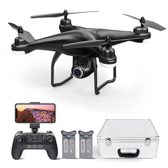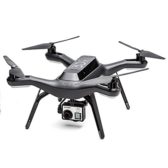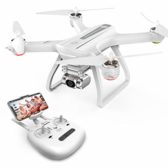The 7 Best GoPro Compatible Drones in 2021
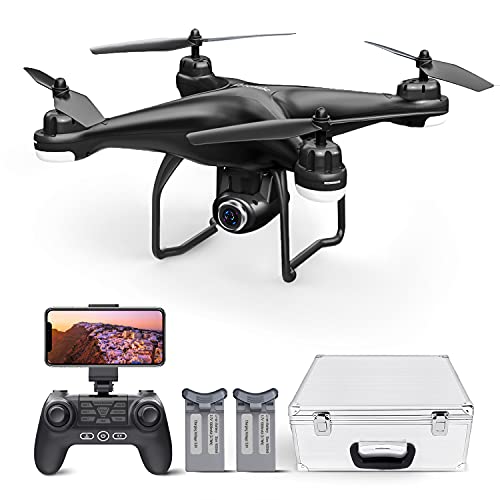
Potensic D85
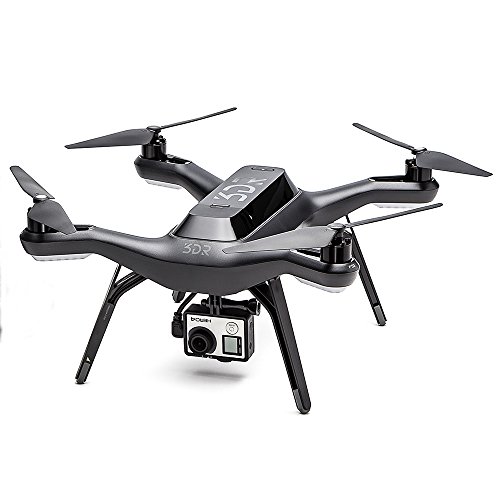
3DR Solo Quadcopter
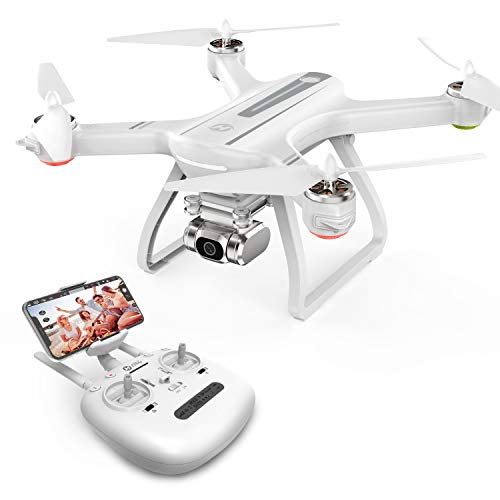
Holy Stone HS700
GoPro cameras and drones are indeed a match made in heaven, combining the dynamic photography of the former and the aerial maneuverability of the latter.
It’s surprising, then, that there aren’t a lot of GoPro drones in the market. At least, not as many as before. The discontinuation of the official GoPro drone, Karma, further cast a shadow on the future of this category.
But as it stands, there are still plenty of drone options for the GoPro owner – if you know where to look. And in the interest of taking the guesswork out for you, we’ve rounded out the best GoPro drones you can buy today.
Best GoPro Drones
We may receive compensation on qualifying purchases via our links. This does not change how we review items. For more information, please read our affiliate disclosure.
A fast, affordable drone with decent battery life, capable of recording 2K video footage.

- Flight Time: 20 minutes
- Range: Up to 1500 metres
- Camera Resolution: 1080p HD
- Weight: 525g
The D85 is one of the more advanced drones in Potensic’s lineup. It’s actually a multi-purpose role that can fill quite a lot of roles, from photography to even racing.
The drone does have its own 2K camera included and is incredible if the photo quality is what you’re after. But the great thing is you can remove this and mount your own GoPro camera with the D85.
One hiccup is that the mount itself is fixed – there’s no gimbal or image stabilization. This makes your camera footage prone to sudden jerky movements. You either need to be very careful or opt for a GoPro camera with the most advanced image stabilization you can find.
Fortunately, it does make it up with flight performance and features, thanks to its durable and powerful brushless motors. One of these is its flying speed.
If you’re used to using your GoPro for capturing high octane, blazingly fast shots, you might complain that a lot of drones today can’t even get close to that speed. Good thing the D85 can clock in at 50 km/hour, finally giving you the chance to capture fast, aerial shots.
The flight time is superb as well, with a 2,800 mAh battery that gives around 20 minutes of flight time. But since you’re getting a free spare, you can effectively fly for 40 minutes straight, with just a short battery swap in between.
Up until now, we’ve covered GoPro drones with just manual flying features; thankfully, the D85 goes beyond that. You have access to GPS features like Auto Return and Altitude Hold. You can also set a pre-determined path for your drone, or use Orbit mode to circle around a subject. For beginners, One Touch Takeoff/Landing and Headless Mode are appreciated.
For a good GoPro drone experience, the Potensic D85 is highly recommended. It has all the flight features and modes a GoPro user would ever need, plus fast speeds to achieve dynamic shots.
+ Pros
- Cons
This is a great Follow Me drone if you already own a Go Pro camera, with a 55mph top speed.

- Follow Me Method: GPS
- Flight Time: 20 minutes
- Camera: none; supports mounting of a Go Pro camera
- Weight: 3.3 pounds
With the “world’s smartest Go Pro drone” moniker, you might have guessed that it’s also one of the most advanced. The “first drone with a brain” is equipped with twin 1 GHz processors, giving it the juice to power its intelligent features.
Let’s get a few negatives out first. Sadly, the 3DR Solo is only usable with either GoPro Hero 3 or 4 cameras. If you own a different model, tough luck.
Next, at this price tag, it doesn’t come with an equipped gimbal, although you CAN buy it as a separate accessory. We HIGHLY recommend you get it if you’re considering this drone, and here’s why.
Not only will it give you camera stabilization for extra smooth shots, but it also provides one of the best GoPro-drone integrations we’ve seen in the market. The connection is so tight that it feels like the camera is actually part of the drone.
You can do FPV from your GoPro straight into your iOS/Android app. You’re also able to start/stop the camera, and access settings mid-air, without needing to land the drone. In short, it’s 100% total control over your GoPro camera.
That, in our opinion, warrants the extra cash you’ll spend for the gimbal (but we really wished it was already included in the base drone).
Aside from GoPro features, flying the 3DR is also a superbly enjoyable experience. You get access to a lot of smart features like Follow Me, Orbit, Cable Cam, and Selfie modes. Thanks to the processing power of the 3DR, it executes these auto flight modes really well, with no jerkiness or awkward movements.
As far as experience goes, you need zero to be able to fly the 3DR Solo. Yet it has enough advanced features to cater to more advanced pilots.
If you’re a GroPro owner that wants the best aerial experience that works really well with your camera, the 3DR Solo is the drone to get.
+ Pros
- Cons
No products found.
Holy Stone’s first GoPro-compatible drone; the HS700 works with the Hero 2, 3 and 4.

- Flight Time: 20 minutes
- Range: 400 meters
- Supported GoPro models: Hero 2, 3 and 4
Marking Holy Stone’s foray into GoPro drones is the HS700, with plenty of advanced flight features and intelligent modes.
If you own a GoPro Hero 2, 3, or 4, this drone is compatible with those models. If not, don’t worry, as it has its own 5G 1080p HD camera. It’s actually not bad and is enough to make this a good drone to buy even if you don’t own a GoPro camera.
One drawback of using a GoPro camera is that you won’t get to exploit the 5G FPV support from the HS700, which is a shame. You can only do that with the included camera.
Being a simple mount, the HS700 doesn’t have a gimbal installed. This is terrible, as it can potentially lead to jittery footage, and you’ll have to rely solely on your GoPro’s image stabilization and your own steady hands to produce smooth footage.
Luckily, the HS700’s flight features make up for this deficiency.
It has onboard GPS, which powers a lot of its intelligent and safety features. Auto Return is the most basic, which enables the drone to automatically go back to its takeoff point once it reaches a critical battery level, or loses connection with your remote controller.
You can also orchestrate complex shots efficiently with HS700’s smart flight features. With Follow Me, have the drone follow you around hands-free, while Points of Interest will have the HS700 circle around and take shots of the chosen landmark. For really complicated sequences, you can draw the exact path you want the drone to follow with Custom Flight Path mode.
Other notables include the long flight time of 20 minutes thanks to the modular 2,800 mAh battery. The brushless motors are also powerful yet quiet, and quick release propellers make replacing rotors a snap.
For GoPro users wanting a powerful drone that won’t cost a fortune, the Holy Stone HS700 is a good pick. You’ll get access to advanced flight features, long battery life, and exceptional performance.
+ Pros
- Cons
No products found.
Compatible with almost all Hero GoPros, this nippy little drone has a lot to offer.
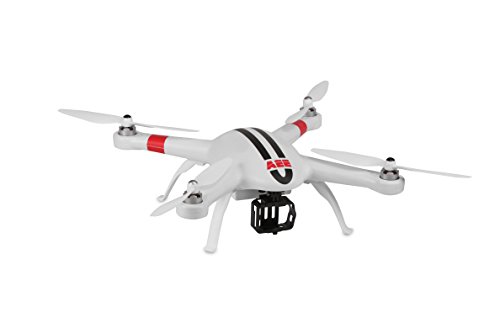
- Flight Time: 25 minutes
- Range: 500 meters
- Supported GoPro models: GoPro Hero 2 to 7
This Phantom-like drone is AEE’s GoPro drone, the AP9. While looks are similar, it’s just a fraction of the price of the DJI version.
What it did right, though, is in terms of flight time. The included 5,300 mAh LiPO intelligent battery is capable of regulating its performance, giving it a maximum flying time of 25 minutes.
The AP9 is designed to hold most of the Hero models in the GoPro line, as well as the AEE series cameras. It has no camera on its own, so really, this is a drone that’s mostly for GoPro owners only.
The drone itself is a rugged little flyer. Its powerful 10-inch rotors are capable of sustaining a large amount of lift, attaining top speeds of 70 km/h. The drone has some resistance to the elements, including rain, snow, and wind.
This is the perfect match for the ruggedness and durability of the GoPro and allows you a bit more freedom on where and when you fly and capture footage.
It has a whole suite of flight instruments that give it incredible performance – GPS, barometric pressure sensor, 3D compass, and a 6-axis gyro. This provides the ap9 with the fantastic ability to hold its position stably. It also gives access to some essential GPS features like Auto Return, and safety protocols to reduce the risk of crashes.
The big drawback of the AP9, however, is that it takes some know-how to calibrate it properly. For beginners, this can be awkward, and somewhat of a hassle for pros. This is probably the biggest complaint mentioned most in reviews.
But overall, if you want a rugged and sturdy Go Pro drone that can stand up to the elements, the AEE AP9 fits the bill.
+ Pros
- Cons
The Blackhawk is a long-lasting, good range drone at a low price. Good for those that aren’t looking for advanced features.
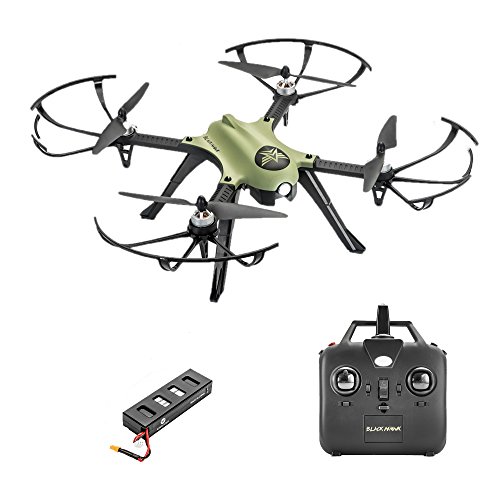
- Flight Time: 15 – 17 minutes
- Range: 500 meters
- Supported GoPro models: Hero 3 and 4
The Altair Aerial Blackhawk is a heavy-duty GoPro drone that comes in at an attractive price.
Compared to the plastic drones in its price class, the Blackhawk is made of a full metal body, giving it superior durability. Crashes won’t present a problem to this drone.
This substance and weight are what lifts the Blackhawk from toy drone territory and puts it in the lower end of the hobby drone category.
The mount on this drone supports both GoPro Hero 3 and 4; unfortunately, that’s about it. You can try action cameras from other brands if they fit. As long as they do, then you can use it with the Blackhawk.
However, this means that this drone doesn’t offer much in GoPro integration. No native FPV or controls on the fly here. For the price, well, this can be expected.
The Blackhawk’s flight performance is pretty commendable. It’s fast and powerful, with a long 500-meter range and long 15 – 17 minutes of flight time. Speed controls let you adjust how fast you want this drone to zip through.
And the heavy-duty body we mentioned actually works to the Blackhawk’s favor instead of dragging it down; all that heft makes it resistant to strong winds and gives it excellent stability.
This actually makes the Blackhawk not just a good GoPro drone, but a great starter drone overall. Even without a camera mounted, you can enjoy flying this bird around. In fact, removing the camera will improve handling and flight times by a wide margin.
Indeed, you can get carried away flying this drone around. Luckily, one of the safety features in the Blackhawk is the built-in Automatic Lock Protection, which helps prevent the brushless motors from burning out.
Unfortunately, it suffers from the same problems other GoPro drones in its price class has – no advanced features and non-existent GoPro integration.
But for the superb flying and heavy-duty construction, the Altair Aerial Blackhawk is a fantastic purchase for a lot less.
+ Pros
- Cons
This dirt-cheap drone is compatible with all GoPro models thanks to its camera mount.
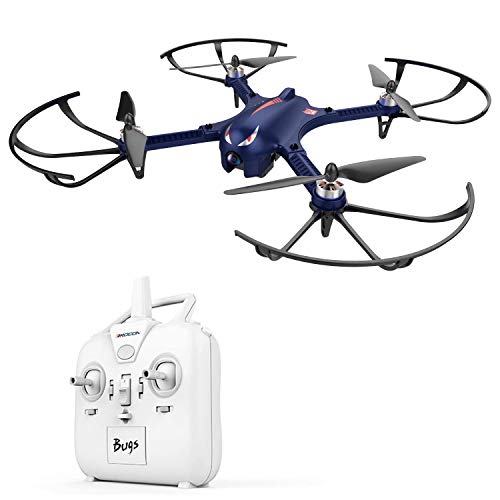
- Flight Time: 15-20 minutes
- Weight: 1.4 kg
- Supported GoPro models: Hero 2 to Hero 7, Fusion, Plus
The Drocon Bugs 3 is one of the most affordable GoPro drones in the market and, in fact, out of all drones in general. Costing less than $100, a lot would mistake this as a toy drone. And while it can be, it has some features that pro and casual GoPro users can appreciate.
First good thing right off the bat is that it can support all GoPro models and even other action cameras. So whatever you got, the Bugs 3 can most likely support that.
The Bugs 3 has an efficient 1,800 mAh LiPO battery, giving it a flight time of around 15 minutes. If you’re just flying it as is, you can achieve 18 -20 minutes of uninterrupted flight. The battery is easily swappable, thanks to its portable design.
Flight stability is one of the Bugs 3’s strongest suits. It’s substantially heavier than most starter drones, but that gives it a lot of heft to resist strong winds. The nylon fiber material is durable as well, giving it decent resistance to crashes and bumps.
The powerful brushless motors give it a lot of lift and power, and the 6-axis gyro lends its stability. This is a fast-flying drone with adjustable speed settings. Which is perfect since fast action shots are the specialty of a GoPro camera.
When it comes to flight features, however, you might find the Bugs 3 a bit lacking. No GPS means none of the necessary safety features like Return to Home or Altitude Hold. It does have low power and signal alarms, so you’ll know when you need to start landing the drone.
So, in essence, this is a drone that you’ll have to fly yourself manually. But it handles well enough that seasoned pilots won’t mind, while beginners can pick it up quickly.
Overall, the Drocon Bugs 3 is a super cheap and basic GoPro drone. If you’re just looking for something to mount your GoPro on, without any of the bells and whistles, then this is an easy purchase to make.
+ Pros
- Cons
This is more like a GoPro Hero drone — it’s only compatible with the Hero 3 and 4 GoPro models.
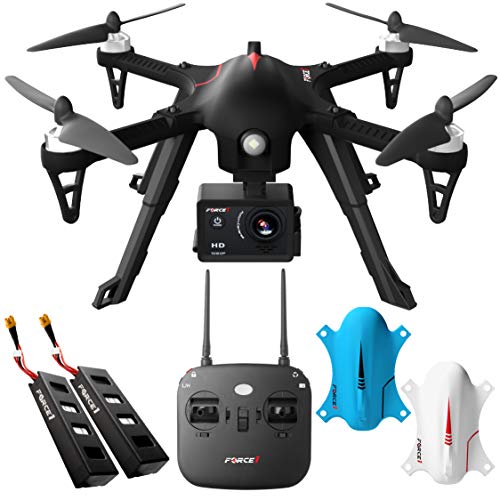
- Flight Time: 15 minutes (per battery)
- Charge Time: ~100 minutes
- Range: 500 meters
- Remote Controller: dedicated controller included
- Camera: 1080p HD + GoPro compatibility
- Weight: 82g
- Outdoor use only
The Force1 F100GP is a slightly more advanced drone, with the addition of the built-in 1080p HD camera. This is so those without a GoPro can still capture photos and videos with the drone.
Of course, for GoPro owners, this hardly matters. What matters is what models the F100GP can support. Unfortunately, not much – it can only mount Hero 3 and 4 models.
The F100GP comes with two high capacity 7.4V 1,800 mAh battery, each capable of around 15 – 17 minutes of flight time. This effectively puts your total at 30 minutes, without the need to invest in spare batteries. Not too bad.
With regards to flight, though, don’t expect a lot of features with the F100GP. No GPS, no altitude hold – this is a raw, no-holds-barred drone that needs to be flown manually. There’s also no tight GoPro integration, so you’ll need to control your GoPro camera manually. No FPV here as well.
Don’t get us wrong, though – the Ghost flies exceptionally well. The two-joystick remote controller will feel instantly familiar to video gamers. Even if not, you’ll still find the controls to be intuitive to use.
And boy, can the ghost fly! Equipped with powerful brushless motors give it powerful lifting capacity, and its speed can be adjusted through two settings. You can even do 360 flip stunts to wow your friends (or try recording that for really cool footage). Plus, it has extra propellers and propeller guards for additional insurance against crashes.
A cool but minor addition is the included shells, in three different colors. This gives you the freedom to change the look of your drone to make it your own.
Overall, The Force1 F100GP is an affordable GoPro compatible drone. The included action camera is perfect for those without a GoPro yet, but we find it won’t make much of a difference. After all, if you don’t have a GoPro, you can just go for a different drone.
+ Pros
- Cons
What Are The Advantages Of A GoPro Drone?
Buying a drone with a camera already on it is undoubtedly convenient and cheaper overall (GoPros aren’t exactly budget cameras). But when you’re already the owner of a GoPro camera, having the ability to mount it onto a GoPro-compatible drone has its advantages.
It usually costs less
OK, you might argue that the cost of getting both a GoPro and a drone is significantly higher than just a camera drone itself. But if you’re an existing GoPro owner looking to expand to aerial photography, it’s much more economical
There are plenty of camera-less drones in the market which support mounting a GoPro. Some may cost as little as $100, and even the expensive ones rarely go beyond the $500 mark. But the good thing is that even at that cost, you’re not sacrificing camera quality. You’re still benefitting from the amazing footage that your GoPro can produce.
They’re more flexible
Drones that are GoPro compatible are incredibly flexible. Of course, you’ll mostly need a reliable camera drone, so having a GoPro mounted on the drone will be the default in most cases.
But if you just want to play around with your drone, then you definitely can. Removing the GoPro reduces the weight of the drone significantly, giving you better flight time and maneuverability. In a way, you get to buy two drones for the price of one.
It’s easier to upgrade the camera
If you bought a camera drone and you’re not too happy with the photo and video quality, then you’re out of luck. You either have to replace the whole drone or just be content with it.
Not the case with GoPro-compatible drones. You have the freedom to replace it with any camera as long as your drone can support it. There’s a new GoPro coming out with better resolution? You can get that one! Some drones even support mounting action cameras from other brands like Xiaomi.
This “modularity” gives you incredible flexibility by allowing you to upgrade the camera or the drone separately from each other. You can also swap different cameras around to experiment with various effects, all from the same drone.
There’s less of a learning curve
Using a drone for the first time certainly has a learning curve to it. The most significant is actually flying the thing, of course. On top of this, there are also lots of other features you need to get acquainted with, such as the camera.
But if you own a GoPro-compatible drone, then you can reduce this learning curve somewhat. Because you’re already familiar with the look and features of your GoPro camera, there’s no need to familiarize yourself with a new one.
So, really, all you need to do is focus on flight basics. And with today’s drones, you don’t even need a high level of skill – most have newbie-friendly auto flight modes that make it incredibly easy to operate them even with minimal experience.
Oh, and the good thing is that, since you can un-mount your GoPro camera, you can practice flying the drone without one. This puts the camera at zero risk of damages if you crash your drone (and, trust us, you will).
If you’re serious about learning and want the lowdown on the best drones to start with, might we recommend our best drones for beginners article
Could You Fit A GoPro To Any Drone?
In a word: no. Most drones nowadays already have a camera built-in, and as such, will not supporting mounting of a third-party one. And even if you managed to do it, it might negatively affect the drone’s flight performance.
The truth is, the availability of GoPro compatible drones are getting less and less these days. (The official GoPro drone, the Karma, getting discontinued doesn’t help, either).
So with the few GoPro-compatible drones available in the market, you’d want to make sure that they will really work as intended. It’s easy enough to see “can be used with GoPro” in the product specs, but will it really do a good job?
Buyer’s Guide: GoPro Drones
Able to handle the load
For one, these drones should be robust enough to carry the weight of your GoPro camera. Usually, the drone’s design and flight power will take into account the weight of varying models of GoPro and other action cameras. You’ll want the drone to have decent flight time, plus be able to maneuver properly even with the camera mounted on it.
Has a gimbal mount
Next, you’d want a GoPro drone with a gimbal on the camera mount. Gimbals are mechanical devices that can rotate the camera independently of the drone. They can thus cancel out the drone’s movement by moving against it, leading to more stabilized footage.
Even though GoPro cameras have their own image stabilization, a gimbal can give superior results. They also allow you to rotate and move the camera while the drone is in the air, so you can frame shots easier.
Can access your GoPro directly
One optional but highly recommended feature is the ability of the drone to access the GoPro camera directly. It’s as if the GoPro is part of the drone itself, allowing you to control a wide variety of useful functions.
The most crucial of this is FPV (First Person View) mode. Advanced GoPro drones will allow live footage from the GoPro camera to stream directly to your remote controller screen or smartphone app. In essence, this gives you that first-person experience, as if you’re inside the drone and flying it yourself.
You can also start or stop the camera and access camera settings to make adjustments on the fly. All of this is done through the drone’s controller or app, making things super easy and convenient.
Can fly at high speeds
GoPro is an action camera. That means it’s meant to capture dynamic footage containing lots of extreme movement. It’s the reason why a lot of folks usually mount the GoPro into their helmet or car while doing a fast sport, such as biking or racing.
If you want to replicate that with your aerial photography, you might want to get a drone that’s capable of fast speeds.
Racing drones are a natural at this, but there’s not a lot that supports mounting a GoPro (unless it’s a DIY kit). This is where the smaller, budget GoPro drones come in. While they may lack some of the more advanced features, they make up for it by being blazingly fast.
Can withstand the elements
GoPro cameras are naturally resistant to the elements, such as rain and snow, which is why they’re quite popular. If you’re continually taking footage in extreme conditions, then you optionally want a drone that can keep up with it.
Unfortunately, there aren’t a lot of rugged drones that can do this, save for a few models (we cover one later in this review). Alternatively, you can look at some waterproof drones. Most have mounts that you can mod to fit your GoPro camera.

